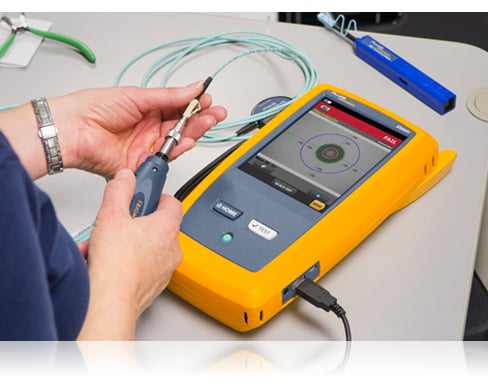Professionals use optical fibre testing equipment to maintain stable data transmission.
Professionals use optical fibre testing equipment to maintain stable data transmission.
Blog Article
Discover the Significance of Optical Fibre Screening in Modern Telecom
In the realm of modern telecommunications, the importance of optical fiber testing can not be overemphasized, as it offers as the backbone for making certain network dependability and efficiency. By applying routine screening procedures, operators can preemptively determine potential issues such as signal destruction, therefore protecting against interruptions that might verify costly. Advanced methods like Optical Time-Domain Reflectometry play an essential duty in this process, yet numerous might ignore the more comprehensive implications of these practices. What are the certain advantages that regular testing deals, and just how might it form the future landscape of telecommunications?

Comprehending Optical Fibre Screening
Optical fiber testing is an essential procedure in telecommunications that makes certain the integrity and performance of fibre optic networks. This screening includes a variety of procedures made to examine the physical and functional attributes of optical fibres - ofda. Trick parameters examined consist of optical power loss, bandwidth capability, and fault place, which are vital for maintaining top quality communication web links
The screening procedure typically includes the use of customized devices such as Optical Time-Domain Reflectometers (OTDR) and Optical Power Meters. OTDRs are used to identify and characterize faults, mates, and adapters within the fibre, while power meters measure the transmitted light signal stamina to establish performance.
In addition, testing is carried out at various stages, including throughout installment, maintenance, and troubleshooting, to make sure that the network fulfills industry requirements and functional demands. Conformity with standards established by organizations like the International Telecommunication Union (ITU) and the Telecoms Industry Association (TIA) is paramount.
Advantages of Normal Examining
Routine screening of optical fibres returns many advantages that substantially boost network dependability and efficiency. One of the main advantages is the very early detection of possible problems, such as breaks or destruction in the fibre, which can cause pricey downtime if left unaddressed (robotic vision). By recognizing these troubles proactively, telecommunications service providers can reduce service interruptions and make certain constant connection for their clients
Additionally, normal testing helps to preserve the stability of signal top quality. As optical fibers age, their performance can be impacted by aspects such as ecological problems and physical tension. Regular assessments permit the monitoring of signal loss and overall transmission efficacy, guaranteeing that the network operates at optimal levels.
One more significant advantage is compliance with sector standards. Regular testing sustains adherence to regulatory needs, thus reducing lawful and financial risks connected with non-compliance. Moreover, it improves the total life expectancy of the fibre facilities by helping with timely repair and maintenance.

Common Checking Methods
Checking optical fibers utilizes various approaches to make certain the honesty and efficiency of telecommunications networks. this Among one of the most common strategies is Optical Time Domain Reflectometry (OTDR), which examines the whole length of the fibre by sending a pulse of light and gauging the representations created by blemishes or breaks. This method offers detailed details regarding the place and extent of mistakes.
An additional common approach is using Optical Power Meters, which gauge the quantity of light transmitted with the fiber. This strategy assists identify the loss of signal toughness, making sure that it fulfills market criteria. In Addition, Aesthetic Fault Locators (VFL) are utilized to determine breaks or severe bends in the fiber by forecasting a noticeable laser light into the cable.
Insertion loss screening is likewise essential, as it evaluates the loss of signal power resulting from connections and interlaces within the network. The use of Polarization Setting Dispersion (PMD) testing assesses the influence of fiber qualities on signal honesty.
Each of these methods plays an essential role in maintaining the efficiency and dependability of optical fiber networks, inevitably adding to smooth telecoms operations.
Effect On Network Performance
The honesty and performance of optical fiber networks directly influence overall network efficiency. In modern telecoms, the efficiency of information transmission depends heavily on the high quality of the optical fibres utilized. Any degradation in the fiber's problem-- whether due to physical damages, contamination, or extreme flexing-- can result in increased attenuation and signal loss, significantly affecting information stability and you could try this out speed.
Normal optical fiber testing is necessary to determine and rectify possible concerns prior to they show up as network failings or stagnations. Techniques such as Optical Time Domain Name Reflectometry (OTDR) and insertion loss screening allow technicians to gauge the efficiency of fibre web links precisely. These examinations not only evaluate the physical condition of the fibres yet additionally ensure compliance with industry criteria, consequently protecting the network's reliability.
Additionally, a well-kept optical fibre network adds to decreased operational prices and improved consumer complete satisfaction, as end-users experience less disruptions and higher data prices. Inevitably, the emphasis on strenuous optical fiber screening practices acts as a cornerstone for maintaining durable telecoms infrastructure, guaranteeing that service carriers can satisfy the growing needs for data transfer and connectivity in today's electronic age.
Future Fads in Evaluating
As we look ahead, developments in technology are poised to improve optical fiber testing in telecommunications. The rise of automation and artificial knowledge (AI) is anticipated to boost the effectiveness and precision of testing processes. Automated testing systems can conduct extensive assessments with very little human intervention, significantly reducing the potential for look at this now mistakes and expediting time-to-deployment.
Moreover, the integration of maker understanding formulas will make it possible for anticipating maintenance, allowing network providers to anticipate prospective problems before they rise into failures. This proactive strategy not only enhances network integrity but also enhances functional prices.
Another emerging fad is the advancement of mobile testing tools that provide real-time evaluation - optical fibre diameter analyser. These gadgets will empower professionals to execute on-site diagnostics quickly, assisting in quicker resolutions and boosting service top quality
The growth of 5G networks additionally demands the development of testing approaches. As transmission capacity needs increase, traditional screening methods may no more are enough. Innovative remedies such as optical time-domain reflectometry (OTDR) and advanced spectral evaluation will certainly end up being essential in ensuring the integrity and efficiency of high-speed connections.

Final Thought
Finally, optical fibre testing is crucial for guaranteeing the integrity and integrity of contemporary telecommunications networks. Routine testing techniques not only assist recognize possible problems such as signal loss and faults yet also add to improved network performance and customer complete satisfaction. As the need for seamless connection remains to expand, the fostering of advanced testing techniques will play a crucial function in preserving high-quality network criteria and supporting the evolving landscape of telecoms.
Report this page